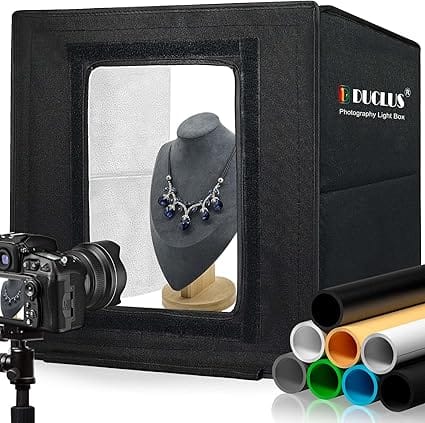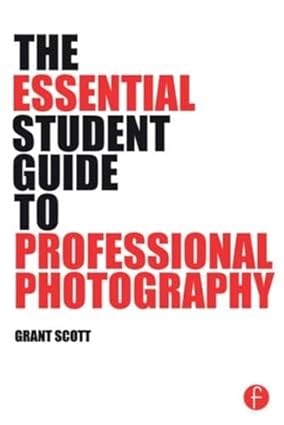Professional photography is a multifaceted art and craft that combines technical expertise, creative vision, and an understanding of human emotions and storytelling. At its core, professional photography is about capturing moments, emotions, and stories in a way that resonates with the viewer, creating lasting impressions and preserving memories. Whether it’s through portraiture, wedding photography, commercial shoots, or artistic endeavors, professional photographers bring a unique perspective and skill set to their work.
Buy from Amazon > Light Box Photography 40cm / 16″ x 16”, Portable Photo Booth Box with Adjustable 160 LED Lights & 8 Photo Backdrops for Product Photography

The Role of Professional Photography
Photography, as an art form, has been integral to human history for over a century. Professional photographers play a pivotal role in documenting significant events, promoting businesses, and creating art that evokes emotion. The distinction between professional and amateur photography often lies in the technical knowledge, creative approach, and quality of the output. Professional photographers excel at crafting images that not only capture reality but also present it in its best light, ensuring that every detail contributes to the narrative or purpose of the photograph.
Buy from Amazon > Canon EOS Rebel T7/2000D For Dummies (For Dummies (Computer/Tech) Book

Storytelling Through Imagery
A hallmark of professional photography is its ability to tell stories. Whether it’s a photojournalist documenting a political rally or a wedding photographer capturing the joy of a couple’s special day, professional photography communicates emotions and narratives that words often cannot. Every detail in a professionally composed image—from lighting and composition to color and texture—is meticulously considered to convey meaning.
Buy from Amazon > The Essential Student Guide to Professional Photography

Versatility and Adaptability
Professional photography encompasses a wide range of genres and styles. Some of the most common types include:
- Portrait Photography: Focused on capturing the essence of individuals or groups, portrait photographers work in studios, outdoor settings, or clients’ preferred locations. This genre requires an understanding of lighting, posing, and how to make subjects feel comfortable.
- Wedding and Event Photography: This involves documenting important milestones and celebrations. Wedding photographers, in particular, must blend technical skill with the ability to anticipate candid moments.
- Commercial and Advertising Photography: These photographers work to create compelling images for products, services, or businesses. Their work often involves collaboration with brands, art directors, and marketing teams to ensure the images align with the company’s vision.
- Landscape Photography: Specializing in capturing natural or urban environments, landscape photographers use their skills to highlight the beauty and majesty of a scene.
Buy from Amazon > VL100C Portable LED light, LED Camera Light Dimmable 3200-6500K with Cold Shoe Mount, for DSLR Camera and Vlogging, Youtube, TikTok Live Streaming and Photography Portrait

- Editorial and Photojournalism: Professionals in this field aim to capture moments that tell real-world stories, often for newspapers, magazines, or online media.
- Fine Art Photography: This genre allows photographers to express their creative vision and produce art that can be sold or exhibited.
- Wildlife Photography: Capturing images of animals in their natural habitats, wildlife photography demands patience, technical skill, and often a deep understanding of the natural world.
- Fashion Photography: This involves photographing models and clothing for advertisements, magazines, or portfolios, emphasizing style, elegance, and trends.
Buy from Amazon > 135° 18mm 2X Macro Probe Lens with 17mm Thread for Mobile Phone Video Recording, for NEEWER Phone Cage/Phone Case with 17mm Lens Adapter Compatible with iPhone Samsung, LS-51

Essential Skills and Equipment
Professional photography requires a combination of artistic sensibility and technical expertise. Here are some key elements that contribute to a successful career in professional photography:
Technical Proficiency
Modern photography heavily relies on understanding camera mechanics, lens types, and post-processing software. Professional photographers must master the following:
- Camera Settings: Knowing how to control shutter speed, aperture, and ISO to achieve the desired effect.
- Lighting Techniques: The ability to manipulate natural and artificial light to create mood and depth in an image.
- Post-Processing: Using software like Adobe Photoshop and Lightroom to enhance images, correct imperfections, and create a polished final product.
Creative Vision
A professional photographer’s creative vision sets their work apart. This includes:
- Composition: Understanding the principles of framing, balance, and leading lines to create visually appealing images.
- Attention to Detail: Capturing nuances that add depth and interest to a photograph.
- Storytelling Ability: Crafting images that evoke emotion and communicate a message.
Communication and Interpersonal Skills
Photographers often work with clients, models, and teams, making effective communication crucial. Building rapport with subjects can help them feel at ease, resulting in more authentic and engaging images.
Business Acumen
For those running their own photography business, understanding marketing, pricing, and client management is essential. Professionals must balance their artistic pursuits with the demands of running a sustainable business.
High-Quality Equipment
While creativity and skill are paramount, the right equipment enhances a photographer’s ability to deliver professional results. Some essential tools include:
- Cameras: Professional photographers typically use DSLRs or mirrorless cameras with advanced features and interchangeable lenses.
- Lenses: A range of lenses, such as wide-angle, telephoto, and prime lenses, allows photographers to achieve various effects.
- Lighting Equipment: Studio lights, reflectors, and diffusers are crucial for controlling light.
- Tripods and Stabilizers: These tools help achieve stability and precision in shots.
- Editing Software: Post-processing tools are indispensable for refining images.
Challenges and Rewards
The path of a professional photographer is not without its challenges. Competition in the industry is fierce, and staying relevant requires continuous learning and adaptation. Photographers must also deal with unpredictable circumstances, such as weather conditions for outdoor shoots or uncooperative subjects.
Despite these challenges, the rewards of professional photography are immense. It offers opportunities for creative expression, the satisfaction of preserving memories, and the ability to make a meaningful impact through imagery. For many, photography is not just a career but a passion that allows them to connect with people and the world in unique ways.
The Importance of Professional Photography in Modern Society
In today’s visually driven world, professional photography plays a critical role in various sectors:
- Marketing and Advertising: High-quality images are essential for promoting products and services, building brand identity, and engaging audiences.
- Media and Journalism: Photographs are integral to storytelling in news and editorial contexts, helping to inform and inspire readers.
- Personal Milestones: Professional photography ensures that significant life events are beautifully documented and preserved for future generations.
- Art and Culture: Photographers contribute to the cultural fabric of society, creating art that inspires and challenges viewers.
- Education and Awareness: Images can raise awareness about social, environmental, and humanitarian issues, driving change and advocacy.
The Future of Professional Photography
The field of professional photography is constantly evolving, driven by technological advancements and changing societal trends. Key developments shaping the industry include:
- Digital Innovations: The rise of AI-powered editing tools, high-resolution sensors, and advanced camera features continues to expand the possibilities of photography.
- Social Media Influence: Platforms like Instagram and TikTok have transformed how images are consumed and shared, creating new opportunities for photographers to showcase their work.
- Sustainability: As environmental concerns grow, photographers are increasingly focusing on eco-friendly practices, such as using renewable energy sources and reducing waste in their workflows.
- Diversification: The demand for diverse representation and inclusive storytelling is reshaping the industry, encouraging photographers to capture a broader range of perspectives and experiences.
- Education and Accessibility: Online tutorials, workshops, and affordable equipment have made photography more accessible, inspiring a new generation of creators.
Conclusion
Professional photography is a dynamic and rewarding field that combines artistry, technical skill, and a deep understanding of human experiences. It has the power to document history, promote businesses, and create lasting connections through imagery. Whether capturing fleeting moments or crafting deliberate compositions, professional photographers play a vital role in preserving and shaping the way we see the world.
Photography has the power to freeze moments, tell stories, and evoke emotions in ways words often cannot. Across genres and styles, there are moments in photography that stand out as particularly impactful or memorable. Whether you’re an amateur with a smartphone or a seasoned professional, recognizing these moments can elevate your appreciation and skills. Here are ten of the best photography moments to inspire your journey, capturing life’s fleeting beauty through the lens.
1. Golden Hour Magic
The “golden hour” refers to the brief period shortly after sunrise or before sunset, when the sun casts a soft, warm glow. This moment transforms everyday scenes into dreamy landscapes, with rich tones and gentle shadows. For photographers, the golden hour provides the perfect lighting to capture portraits, landscapes, and cityscapes. The light is flattering, minimizing harsh contrasts and creating a sense of intimacy and warmth.
For example, photographing a serene lake at sunrise often yields reflections tinged with gold and pink hues, creating a tranquil and ethereal atmosphere. Similarly, portraits taken during this time have a natural softness that enhances skin tones and adds depth.
2. The Decisive Moment
Coined by legendary photographer Henri Cartier-Bresson, the “decisive moment” refers to capturing a split second that tells a complete story. These moments often occur unexpectedly, requiring photographers to anticipate and react quickly. Whether it’s a child laughing uncontrollably, a bird taking flight, or a street performer’s dramatic gesture, the decisive moment is about timing and intuition.
Street photography is especially rich with decisive moments. For instance, a silhouette framed against a graffiti wall or a fleeting interaction between strangers can create an image that resonates deeply with viewers. Practicing patience and observing your surroundings can help you capture such moments.
3. Candid Expressions
Candid photography captures people in their natural state, free from posed stiffness or forced smiles. The beauty of these moments lies in their authenticity—raw emotions that connect with the viewer. Weddings, family gatherings, and street scenes are ripe with opportunities for candid shots.
A candid photo might show a child’s genuine curiosity while exploring, a couple sharing an unguarded laugh, or a performer’s focused expression mid-act. The challenge is blending into the environment so subjects feel comfortable and uninhibited.
4. Nature’s Spectacles
From thunderstorms to rainbows, and from auroras to eclipses, nature’s spectacles offer some of the most breathtaking moments to capture. These events remind us of the Earth’s grandeur and unpredictability. Wildlife photography, too, falls under this category, with scenes like a lioness tending to her cubs or a flock of birds in synchronized flight.
Patience and preparation are key. For instance, capturing a meteor shower requires knowledge of timing and location, as well as equipment suited for low-light conditions. The reward is an image that inspires awe and celebrates the wonders of our planet.
5. Celebratory Moments
Photographing celebrations—festivals, parades, birthdays, or cultural rituals—offers a window into the vibrant tapestry of human life. The colors, emotions, and energy present in these settings create opportunities for dynamic and impactful photos.
For instance, capturing Holi, the Indian festival of colors, offers a chance to photograph people drenched in vibrant hues, their joy and camaraderie palpable. Similarly, fireworks displays at New Year’s or national holidays allow photographers to experiment with long exposures to create dazzling light trails against the night sky.
6. Motion and Action
Action photography captures subjects in motion, conveying energy and excitement. Sports, dance, and adventure photography are prime examples where motion plays a central role. Freezing a skateboarder mid-air, a runner crossing the finish line, or a wave crashing against the rocks requires technical precision and creativity.
Panning is a popular technique to capture motion. By following a moving subject with your camera while using a slower shutter speed, you can create a blurred background that emphasizes speed and movement. The resulting image can feel dynamic and alive.
7. Juxtaposition and Contrast
Photography thrives on contrasts, whether visual or thematic. Juxtaposition involves placing two seemingly unrelated elements together to create a compelling narrative or visual tension. It could be an elderly person walking past a wall covered in youthful graffiti or a modern skyscraper towering over a historical monument.
These moments challenge viewers to think and interpret, making them especially impactful in photojournalism and conceptual photography. They highlight differences, provoke thought, and invite a deeper exploration of the story behind the image.
8. Reflections and Symmetry
Reflections and symmetry add balance and intrigue to photographs, drawing viewers into the scene. Water surfaces, mirrors, and glass windows are excellent mediums for reflections. A cityscape mirrored in a calm river or a mountain reflected in a pristine lake can create mesmerizing compositions.
Symmetry, whether natural or man-made, brings a sense of harmony to photos. Architectural photography often exploits symmetry—capturing the perfect alignment of a corridor, staircase, or facade. These elements lend a sense of order and beauty to the frame.
9. Human Connections
Some of the most poignant photos depict human connections—moments of love, friendship, or solidarity. These images resonate universally, reminding us of shared experiences and emotions. A parent holding a child’s hand, friends embracing after a long separation, or strangers helping each other during a crisis are powerful subjects.
The key to capturing these moments lies in empathy and observation. Being present and attentive allows you to recognize and document these connections authentically.
10. The Unexpected
Some of the best photography moments happen when least expected. Spontaneous events, like an animal photobombing a shot or an unplanned change in weather, can lead to unique and memorable images. Being prepared to adapt to the unexpected is a skill that can elevate your photography.
For example, a sudden downpour might create opportunities for stunning rain-soaked streets or reflections in puddles. Similarly, stumbling upon a street performance or an unplanned gathering can result in photos that feel fresh and unrehearsed.
Conclusion
Photography is a blend of technical skill, creativity, and the ability to see beauty in the world around us. These ten moments—golden hour magic, decisive moments, candid expressions, nature’s spectacles, celebratory moments, motion and action, juxtaposition and contrast, reflections and symmetry, human connections, and the unexpected—represent a spectrum of opportunities to create meaningful and impactful images.
By honing your awareness, patience, and technical skills, you can seize these moments and elevate your photography. Whether you’re documenting everyday life or chasing extraordinary scenes, each click of the shutter has the potential to capture a story worth telling.
5 Essential Photography Tips for Stunning Shots
Photography is a powerful medium that captures moments, emotions, and stories. Whether you’re a beginner or an experienced photographer, refining your skills is always worthwhile. Here are five key pieces of advice to enhance your photography and take your shots to the next level:
1. Master the Basics of Composition
Good composition is the backbone of impactful photography. The rule of thirds is a classic technique: divide your frame into nine equal parts with two horizontal and two vertical lines, then place your subject at one of the intersections. This creates a balanced and visually pleasing image. Leading lines, symmetry, and framing are additional compositional tools that draw the viewer’s eye to the subject. Experimenting with angles and perspectives can also add creativity and depth to your shots.
2. Understand Lighting
Lighting can make or break a photograph. Natural light, particularly during the golden hour (shortly after sunrise or before sunset), casts soft, warm tones that are flattering for most subjects. If shooting indoors, utilize window light or soft artificial lighting. Learning to control shadows and highlights is equally important—avoid harsh midday sun that can create unflattering contrasts. For more advanced techniques, explore off-camera flash and reflectors to manipulate and enhance your lighting setup.
3. Get to Know Your Camera Settings
A fundamental understanding of your camera is crucial for capturing professional-quality images. Learn how to adjust the three pillars of photography: aperture, shutter speed, and ISO. Aperture affects depth of field; a low f-number (e.g., f/2.8) creates a blurred background, while a high f-number (e.g., f/11) keeps more of the scene in focus. Shutter speed controls motion blur, and ISO determines your camera’s sensitivity to light. Practice shooting in manual mode to gain full control over these settings.
4. Pay Attention to the Background
A cluttered or distracting background can detract from your subject. Look for clean, simple backdrops that enhance rather than compete with the subject. Alternatively, use a wide aperture to create a shallow depth of field, blurring the background and bringing attention to your subject. When shooting outdoors, position yourself to eliminate distractions, like power lines or busy crowds, from the frame.
5. Keep Practicing and Experimenting
Photography is an art that thrives on continuous practice and experimentation. Challenge yourself by exploring different genres—landscape, portrait, macro, or street photography. Embrace mistakes as learning opportunities and study the work of seasoned photographers for inspiration. Don’t be afraid to try unconventional techniques or post-processing to discover your unique style.

